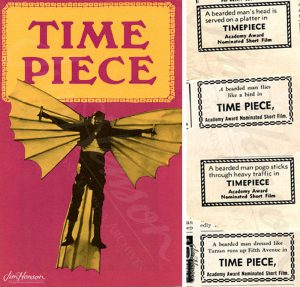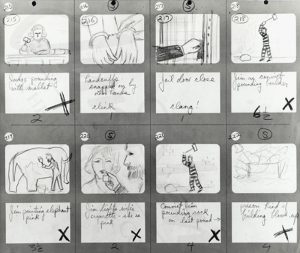Time Piece is a 9 minute experimental film by Jim Henson released in 1965. It was directed, written, and produced by Jim Henson, who also stars. I watched the film at the Jim Henson exhibit in the Museum of the Moving Image in Astoria, Queens. The piece was shown on a small screen alongside Henson’s other experimental and mainstream work. This was one of the few pieces that was live-action, in that it didn’t involve puppetry. Most people know Jim Henson for his work on The Muppets and Sesame Street, which are positioned as cultural icons in the American media canon since the 1960s through modern times. I was pleasantly surprised to find out that Henson’s creativity has been used in a more experimental way while still remaining playful, provocative, and entertaining.

The man goes to work, goes on dates, and lives his relatively mundane life until he is imprisoned for shooting the Mona Lisa, and escapes wearing different disguises until he is shot down by military force.s The film’s end reveals that Henson was experiencing his life condensed in the last moments before his death. The camera moves from the lifeless body to the doctor, who is revealed to be Henson, and he winks at the camera.
The piece begins with Henson at a doctors office in a hospital gown receiving what looks like a routine check up. However, the doctor comes into a problem when he cant find his heartbeat. The film then goes through a series of seemingly unrelated short shots cut together rhythmically, with brief interludes of brightly colored construction paper animation. (The film was actually not written, but each shot was fully storyboarded, which comes across in the visually striking and graphic framing, usually created to make a graphic match).

Each shot lasts only a few seconds, creating a dizzying viewing experience. The soundtrack by Don Sebesky roots the film in a consistent pulse. This is also aided by a lack of dialogue save for Henson’s few utterances of “help”. The film, although distinct from most of Henson’s other work, still very much feels like a Jim Henson project. The acting and direction feels disorienting and bizarre but humorous and relatively accessible. The film uses some visual metaphor (like the repeated shot of painting an elephant pink to represent intoxication) that creates a layer of distance between the viewer’s experience of what is actually a pretty sad life story. It seemed to have its roots in Russian montage, and at times reminded me of DIga Vertov’s Man with a Movie Camera.
